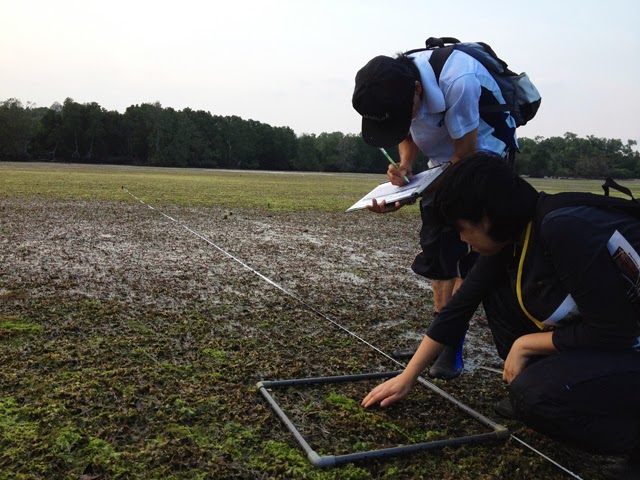Second monitoring trip for 2014 and TeamSeagrass heads to Chek Jawa. It's looking to be another HOT day as the Team boarded the boat to Pulau Ubin.
We had a large group of newbies and some old-bees who had forgotten how to monitor; so we decided today will be a teaching session, where we take it slow and emphasize the finer points of monitoring. After we sorted the old-bees, newbies and stalwarts into groups (this always takes waaay too much time, maybe we need a TeamSeagrass sorting hat?), I did the briefing and we headed out to shore to do the seagrass ID session.
 |
| Siti giving the briefing. |
 |
| Heading out on the boardwalk - there were many visitors around and we didn't want to give the wrong idea by climbing down the "side-route". Also, just like any other group that is allowed access to Chek Jawa, TeamSeagrass had to apply for a permit to carry out our quarterly monitoring. |
 |
| A quick seagrass ID session and we are off! :) |
The inter-tidal elves have been up to mischief because this is the second day that we've found the stakes marking our transect start points missing. At CJ1, only one stake was left standing and from what I hear, there was some trouble locating CJ2 as well. In situations like this, we are relieved to have our trusty GPS to tell us where our sites are. After a quick introduction on how to set up the site (transect lines 2 and 3 were missing from CJ1), we started the monitoring.
I had Loius and Erine in my group, both of whom were relatively new, but enthusiastic and responsive, which is great. It always sucks when you ask a question only to be met with silence; although if I had been given a dollar every time it happens, I think I'd be pretty rich. I did the first 4 or 5 quadrats with Erine and Louis, making sure to emphasize the importance of checking their estimates against the percent cover standards sheets, how to include only seagrasses that have their "footprint" in the quadrat to prevent overestimation, and how to estimate relative species composition. I also taught them how to use the epiphyte cover matrix, which really helps take the guesswork and brain sprain out of estimating epiphyte cover.
 |
| Using the Epi-Matrix to estimate epiphyte cover on seagrass leaves. Its much easier and more accurate to use this matrix because its a standard that's being used across all seagrass monitoring sites. |
 |
| Using the percent cover standards sheets allows us to calibrate our percent cover estimates against the same set of standards used at other Seagrass-Watch monitoring sites worldwide. This makes the data we collect more reliable and comparable to data collected using the same methods at other sites. |
After the 5th quadrat, I decided to take a step back and let my team practice what I've just taught them. I think they did pretty well. The method designed by Seagrass-Watch is meant to be simple and easily replicated, which is what makes it such an ideal method to be used by citizen science groups like ourselves.
 |
| Erine and Louis monitoring seagrass like pros :) |
|
|
|
Looking around, I see the other two transect groups led by Nor Aishah and Rachel hard at work too, which makes my inner dictator happy.
 |
| Rachel with new volunteers Christine and Wan Yi at CJ site 1 transect 1. |
 |
| Nor Aishah with Jocelyn (another one!) and Ivan at CJ1T2. |
All in all, it was a pretty good day, the
Cymodocea rotundata (ribbon seagrass) meadow between the boardwalk and at CJ1 looked to be in pretty good shape despite the heat and sun (which by the way, decided to go play behind some clouds and the wind picked up which made for AWESOME monitoring weather). Although, some of the seagrass on the fully exposed sand mounds looked a little worse for wear - likely from dessication at low tide and over-exposure to direct sunlight.
 |
| Blackened Halophila ovalis (spoon seagrass) likely from overexposure to sunlight coupled with drying out from being exposed during an afternoon low tide. |
 |
| More examples of stress - seagrasses looking bleached. Direct exposure to sunlight at low tide can cause stress to the plant and chlorophyll to break down. |
After wrapping up, we managed to have a bit of a walk about and spotted some cool critters chillaxing in the wetter parts of the meadow, like a sea pen, some cool sea cukes (that's cucumbers), and noble volutes laying eggs. Chek Jawa always has a surprise or two up its sleeve :)
 |
| We activated Ivan and he went into guide mode, telling the newer volunteers about the fun critters we saw :) |
And of course, we saw lots of dugong feeding trails, but it never seems to happen IN our site :( Although, one has to wonder if the trails were really from dugongs or just hungry TeamSeagrass volunteers! ;)
 |
| Dugong feeding trail? Or was Pei Yan feeling peckish? ;) |
That's all for now folks, till our next monitoring trip, TeamSeagrass, signing out! :)
For more on yesterday's monitoring, check out
Mei Lin's blog













No comments:
Post a Comment